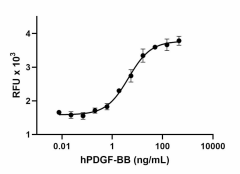- Other Names
- Simian sarcoma viral oncogene homolog, v-SIS, SSV, SIS, c-sis, PDGF2
- Ave. Rating
- Submit a Review
- Product Citations
- publications

-

GMP Recombinant human PDGF-BB induces the proliferation of NIH/3T3 cells in a dose-dependent manner. The ED50 for this effect is 1 - 5 ng/mL.
| Cat # | Size | Price | Save |
|---|---|---|---|
| 577325 | 100 µg | ¥346,500 |
Select size of product is eligible for a 40% discount! Promotion valid until December 31, 2024. Exclusions apply. To view full promotion terms and conditions or to contact your local BioLegend representative to receive a quote, visit our webpage.
PDGF-BB is a mitogen initially identified as simian sarcoma viral oncogene homolog. It belongs to the PDGF family which includes five members, PDGF-AA, PDGF-BB, PDGF-AB, PDGF-CC, and PDGF-DD. PDGF-AA, AB, and BB dimers are processed intracellularly and secreted as active dimers that readily activate PDGF receptors (PDGFRs). PDGF-CC and DD are secreted as full-length, latent dimers, and the proteolytic removal of a CUB domain is required for the growth factor domains of PDGF-CC or DD to activate the PDGF receptors. PDGF-BB exerts its biological functions through the activation of dimeric receptors made up of two structurally similar proteintyrosine kinase receptor subunits (αα-, αβ-, or ββ-PDGFR). PDGF has been characterized as a chemoattractant for vascular smooth muscle cells from both sheep and humans and also for canine tracheal myocytes. In ex vivo cutaneous remodeling studies it was revealed that PDGF-BB is a mitogen and chemoattractant for dermal fibroblast. Abnormalities of PDGFR/PDGF are thought to contribute to a number of human diseases including malignancy. Autocrine signaling as a consequence of PDGF-B overexpression is clearly implicated in the pathogenesis of dermatofibrosarcoma protruberans (DFSP).
Product DetailsProduct Details
- Source
- Human PDGF-BB amino acid (Ser82-Thr190) (Accession: # NM_033016), was expressed in E.coli.
- Molecular Mass
- The 109 amino acid recombinant protein has a predicted molecular mass of approximately 12.2 kD. The DTT-reduced and non-reduced protein migrates at approximately 13 and 37 kD by SDS-PAGE respectively. The predicted N-terminal amino acid is Ser.
- Purity
- > 95%, as determined by Coomassie stained SDS-PAGE.
- Formulation
- Protein was lyophilized from 0.2 μm filtered solution contain 0.1% TFA, 10% Acetonitrile.
- Endotoxin Level
- Less than 0.1 EU per µg of protein as determined by the LAL method.
- Concentration
- 100 μg size is lyophilized
- Storage & Handling
- Unopened vial can be stored between 2°C and 8°C for up to 2 weeks, at -20°C or colder until the expiration date. Reconstitute lyophilized protein in sterile 4 mM HCL. Before reconstitution, make sure sterile 4 mM HCL and product are at room temperature. Quickly spin the vial or gently tap down on the vial to make sure the lyophilized product is at the bottom of the vial before opening. Use aseptic techniques to add the required volume of reconstitution buffer (sterile 4 mM HCL) to the vial, to obtain the recommended stock concentration 250 μg/mL. Close the vial and leave at ambient temperature for 15-20 minutes. Then gently invert the vial several times or until all of the lyophilized product dissolves. Leave the vial at room temperature for another 15 minutes. If small particulates are still observed after 15 minutes, incubate at room temperature for an additional 30 minutes, and leave the vial at 2°C - 8°C overnight. Next day, invert the vial several times or gently pipette the solution up and down before use. If needed, transfer the reconstituted stock solution to a sterile container for additional dilution to no less than 100 μg/mL. Small working aliquots in polypropylene tubes can be made after reconstitution and store the vials at -20°C or lower. Avoid freeze/ thaw cycles. Carrier protein such as 0.2 - 1% endotoxin-free BSA or HSA can be added when preparing the stock solution. Aliquots can be stored between 2°C and 8°C for up to two weeks or stored at -20°C or colder for up to 3 months.
- Activity
- GMP recombinant human PDGF-BB induces the proliferation of NIH/3T3 cells in a dose-dependent manner. The ED50 for this effect is 1 - 5 ng/mL.
- Application
-
Bioassay
- Application Notes
-
Our liophilized proteins are validated in-house to maintain activity after shipping at ambient temperature and are backed by our 100% satisfaction guarantee. If you have any concerns, contact us at tech@biolegend.com.
- Disclaimer
-
GMP Recombinant Proteins. BioLegend GMP recombinant proteins are manufactured in a dedicated GMP facility and compliant with ISO 13485:2016. For research or ex vivo cell processing use. Not for use in diagnostic or therapeutic procedures. Our processes include:
- Batch-to-batch consistency
- Material traceability
- Documented procedures
- Documented employee training
- Equipment maintenance and monitoring records
- Lot-specific certificates of analysis
- Quality audits per ISO 13485:2016
- QA review of released products
BioLegend GMP recombinant proteins are manufactured and tested in accordance with USP Chapter 1043, Ancillary Materials for Cell, Gene and Tissue-Engineered Products and Ph. Eur. Chapter 5.2.12.
Antigen Details
- Structure
- Homodimer
- Distribution
-
PDGF-BB is mainly expressed in vascular endothelial cells, megakaryocytes, and neurons.
- Function
- PDGF-BB regulates diverse cellular processes, including cell proliferation, transformation, migration, survival, and apoptosis of mesenchymal cells, in development and during pathogenesis.
- Interaction
- Mesenchymal-derived cells
- Ligand/Receptor
- αα-PRGFR, αβ-PDGFR, and ββ-PDGFR
- Bioactivity
- Recombinant human PDGF-BB induces the proliferation of NIH/3T3 cells in a dose-dependent manner.
- Antigen References
-
- Carlin SM, et al. 2003. Am J Physiol Lung Cell MoPhysiol. 284:L1020.
- Ustach CV, et al. 2005. Mol Cell Biol. 25:6279.
- Jones AV and Cross NC. 2004. Cell Mol Life Sci. 61:2912.
- Andrae J, et al. 2008. Genes Dev. 22:1276.
- Banerjee P, et al. 2011. J. Biol Chem. 23:33580
- Gene ID
- 5159 View all products for this Gene ID
- UniProt
- View information about PDGF-BB on UniProt.org















Follow Us